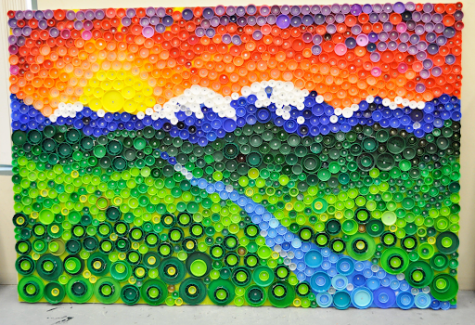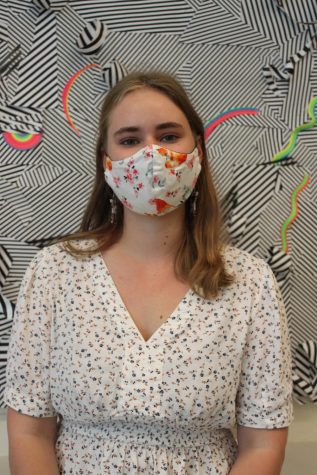What the Numbers on your Plastic Water Bottle Mean: Decoding Recycling

Photo courtesy of the American Chemistry Council
The seven types of plastics
April 13, 2022
“It’s not uncommon to see a recycling symbol on a plastic container and think it’s OK to toss it into the recycling bin,” says Sheryl Ryan, founder of Greenopedia. “But as it turns out, there are several different types of plastic, and some are easier for recycling centers to process than others.”
According to NPR, the average American produces 4.4 pounds of trash every single day. That’s a lot! A simple and easy way to make an environmental impact in your daily life is reducing your personal addition to our landfills. Checking which types of plastic you’re buying is an easy way to make this change.
Every time you hold a piece of plastic, you may notice a small triangle (the recycling symbol) with a number inside it. This number may be small in size but in actuality it’s huge in importance. Many recycling plants will not accept or recycle certain plastics, which is what the numbers denote. Also according to NPR, it’s estimated that 91% of all plastic ever produced hasn’t been recycled, but instead, thrown away. I believe with a little bit of knowledge, this can change.
If you have the choice of which type of plastic to buy or use, types 1, 2, and 5 are the most commonly recycled and best for the environment. To recycle these plastics, they must be cleaned and in good shape when they arrive at the recycling plant.
Some communities or counties have peculiar rules, so looking up your local policies or rules can be helpful. The reason for this is that recycling is a business (sadly). To make money, the recycling plants have to be able to sell the plastic to manufacturers. The plastics have to be easily melted down and work to make new products, or else they won’t be worth anything. Remembering that recycling is for profit is important to recognizing the state of American environmental politics and understanding why these numbers are important.
Most plastic is type 1, which is also the most recycled and always accepted roadside. When looking for plastic when shopping that will actually get recycled, look for type 1. Most plastic drinks, jars, and liquid containers will be type 1. These plastics, along with type 2, also have a low risk of leaching into the environment or your food and water.
Type 2 is also quite common, mostly made up of bottles, and is easily recycled as well. Milk jugs, detergents, and other liquid containers are usually type 2. Type 2 plastic shares many traits with type 1.
Type 3 is uncommon to the average person, containing mostly PVC plastics, and is harder to recycle. It is not usually collected roadside. It is dangerous to cook with, burn, and use this plastic in odd ways. The chemicals and phthalates in PVC are associated with health risks, such as liver problems, so if you can, stay away from them.
Type 4 is likely to not be marked, due to its nature as being plastic bags, toys, and other miscellaneous plastics. These usually require extra steps to be recycled and will need some planning on your part. In my opinion, though, type 4 plastics are the easiest to reuse in new ways, which I will talk about later. Honestly, reducing your consumption of type 4 plastics or reusing them is more environmentally friendly than recycling them.
Type 5 is quite controversial when it comes to its recyclability. Some counties easily accept it while others have no interest in it. Some type 5 plastic, like medicine bottles, should be easy to recycle. However, straws are considered type 5 which should not be recycled as they can interrupt the process for other plastics. This also includes bottle caps, which can be confusing on how to recycle but are important.

Along with being common litter and posing a real threat to animals, bottle caps can also fly out of the recycling machinery, posing a hazard to employees. It is recommended that consumers leave plastic bottle caps on the bottles, rather than separate them. For metal bottle caps, some online sources recommend collecting them all in one metal can and closing the can, before putting them in a recycling bin. Often, artists or schools are looking for these bottle caps as they can be used in bottle caps programs to get funding or used in art projects.
Type 6, usually styrofoam, is almost impossible to recycle and rarely marked. Styrofoam is most commonly trashed instead of recycled if donated to the plant and is very bad for the environment. It dissolves in water which leads to micro-plastics in waterways and due to the fact it’s lightweight, can travel quickly in wind or rain.
Type 7 is unrecyclable as it is usually the other types of plastics mixed together, such as resins. It is the most likely to contain BPA and other chemicals, which are health hazards as well, so it’s best to stay away from this type of plastic. Type 7 is arguably the most annoying plastic and is also one of the most commonly produced because it’s so cheap.
It’s important to separate out the types of plastics your county wants and make sure they are in recyclable condition because items such as straws and bottle caps can make the entire batch of plastics unusable or difficult to recycle, which usually just results in it all being thrown away. It requires extra work for the plant to sort the plastics and/or they can get stuck in machinery. Most people don’t realize that throwing random pieces of plastic into recycling bins can do more harm than good, but simply having this knowledge can help change that.
The most important thing to remember is that just because the recycling symbol is on a piece of plastic or glass does not mean it can be recycled or will be where you live. Choosing types of materials that can actually be recycled is an important individual step you can take to help the environment.
Recycling was created by the plastic industry so that consumers believe they can recycle more than they can and so that people don’t convert to other materials like glass or metal, or simply start reducing their consumption. Fighting this industry is easy, from checking the numbers, being creative with reusing, learning how to compost and DIY, as well as simply using this knowledge to reduce your footprint (which is terminology I tend to disagree with as the carbon footprint was made by the fossil fuels industry, but I also believe it’s worth thinking about how to make your lifestyle more sustainable).
Above all though, the phrase “reduce, reuse, recycle” is set in this order for a reason. Reducing your consumption is the best way to reduce your impact on the environment (and save money). After that, reusing jars, bottles, and bottle caps to store other things takes less energy than recycling them (and saves money once again). You can reuse plastic bags if you have pets and need to throw away their excrement. Lastly, recycling is better than adding to landfills as it allows us to produce fewer plastics.
This past school year, DeKalb county stopped collecting almost all recycling from Chamblee, and I believe other schools, and while students and teachers have voiced concern, almost no explanation has been given. Currently, there is no plan, to at least my knowledge, on returning to recycling.
With such a large student body population, Chamblee can truly reduce its environmental impact by simply re-implementing a recycling program in the cafeteria and while I am graduating this year, I hope future changes are made to make the school more sustainable. Lots of students have an interest in helping do this as well, from the school’s environmental club, volunteering organizations, and environmental science students.
Since the school is no longer helpful, if you’re looking for a place to recycle almost anything, especially glass and plastic, the DeKalb International Farmers Market at 3000 E Ponce de Leon Ave, Decatur, GA 30030-2219 has a large part of the parking lot dedicated to recycling where you sort the materials yourself. DeKalb does collect plastic in roadside recycling bins but does not collect glass and other materials, so sites like the Farmers Market are important to reduce your landfill input.
Overall, while systemic change will be needed to help fight the ongoing climate crisis, every single person can make small changes to their life with just a little bit of knowledge and intention to help protect this beautiful planet we call home.
For other ways to make an impact, check out this article from Blue & Gold alum Catherine Cossaboom.










